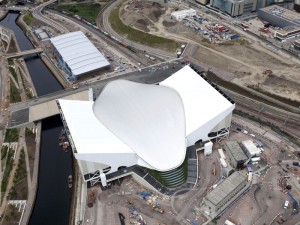London marks 1-year Olympic countdown untroubled

2012 OLYMPICS COUNTDOWN. With exactly a year to go until the start of the London 2012 Games, the Olympic Delivery Authority has announced that the Aquatics Center is now complete, the last of the six main permanent Olympic Park venues to finish construction. AP
LONDON—Six years after being awarded the 2012 Games, London was marking the one-year countdown on Wednesday with the completion of the last of the Olympic Park’s permanent venues and a Trafalgar Square ceremony.
Ahead of an evening concert at the world-renowned London landmark, the 269-million pound ($442-million) aquatics center was to open on the former industrial wasteland that has been transformed by one of Britain’s biggest-ever building projects.
Article continues after this advertisement“It’s a pretty big moment for us,” organizing committee chairman Sebastian Coe said. “Though a mountain of work is still needed to prepare (the venues) we have an extraordinary platform to build on … I don’t think we are sitting here fearful of anything; we have everything under control.”
International Olympic Committee president Jacque Rogge is in London to formally invite the world’s athletes to the games with few of the distractions that overshadowed the one-year countdowns to the previous two Summer Games.
Beijing was battered for its record on Tibet and human rights before the 2008 Olympics, while Athens struggled to the last minute to finish venues in 2004.
Article continues after this advertisementEven the worst global recession for more than 70 years failed to significantly derail London’s plans, with test events already underway and the IOC relaxed about the final 12 months before the games returns to London after 64 years.
The latest milestone will be marked Wednesday evening by 17-year-old Tom Daley taking the first dive in the aquatics center, days after qualifying for his second Olympics.
But the 17,500-capacity venue, which will also be used for swimming, synchronized swimming and water polo events, was expected to be among the first major projects to be finished and one of the boldest architectural statements on the 226-hectare (560-acre) east London site.
Instead it is being completed after the 80,000-seat Olympic Stadium, the velodrome, handball arena, basketball arena and the International Broadcast Centre.
And the aquatics center design was scaled back in an effort to cut spiraling costs even before Britain slumped into recession.
While retaining the sweeping, wave-shaped roof, the size of the venue was reduced to prevent it becoming a white elephant after the games have finished, with two giant wings of temporary seating to be added to accomodate fans during Olympic competition.
“The extraordinary regeneration in east London, all the opportunities, the nation’s and region’s engagement — I can’t look at that Olympic Park without taking pride,” Coe said.
Filling venues has not proved to be a problem. In fact, “a world record-breaking demand for any sporting event on the planet” — according to Coe — has provoked anger about the ballot process for tickets.
“Everybody’s sort of whipping this up into a bit of a storm but peel the layers back: the problem here is essentially that we had 22 million applications for 6.5 million tickets,” Olympics minister Hugh Robertson said. “One in four people are going to be disappointed and there’s nothing we can do about that. If we’d built stadia of twice the size, we’d have faced huge international criticism for building white elephants that couldn’t be used afterwards … everybody else around the world thinks this has been one of the greatest successes that the Olympic Games has ever seen.”
In a year, successes will be judged for each nation by medals, which will be revealed for the first time on Wednesday.
Britain’s challenge now is ensuring its athletes are not burdened by the growing home expectation to match — or surpass — the fourth-place finish in the Beijing medals’ table.
“What have we got to get right? It’s getting our athletes trained,” London mayor Boris Johnson said. “We can’t lose to France or Australia! We came fourth last time. We’ve got to make sure we do better this time and that’s going to be tough. That’s the missing component for me.”
A year from now, Johnson’s city will be welcoming 10,500 athletes from more than 200 countries, 5,000 coaches and team officials, 20,000 media personnel and hundreds of thousands of visitors. The 17-day festival will feature athletes competing in 26 sports in more than 300 medal events in 32 venues.